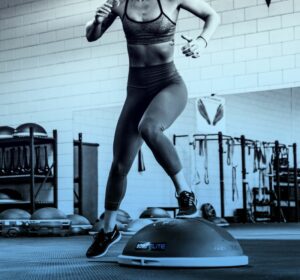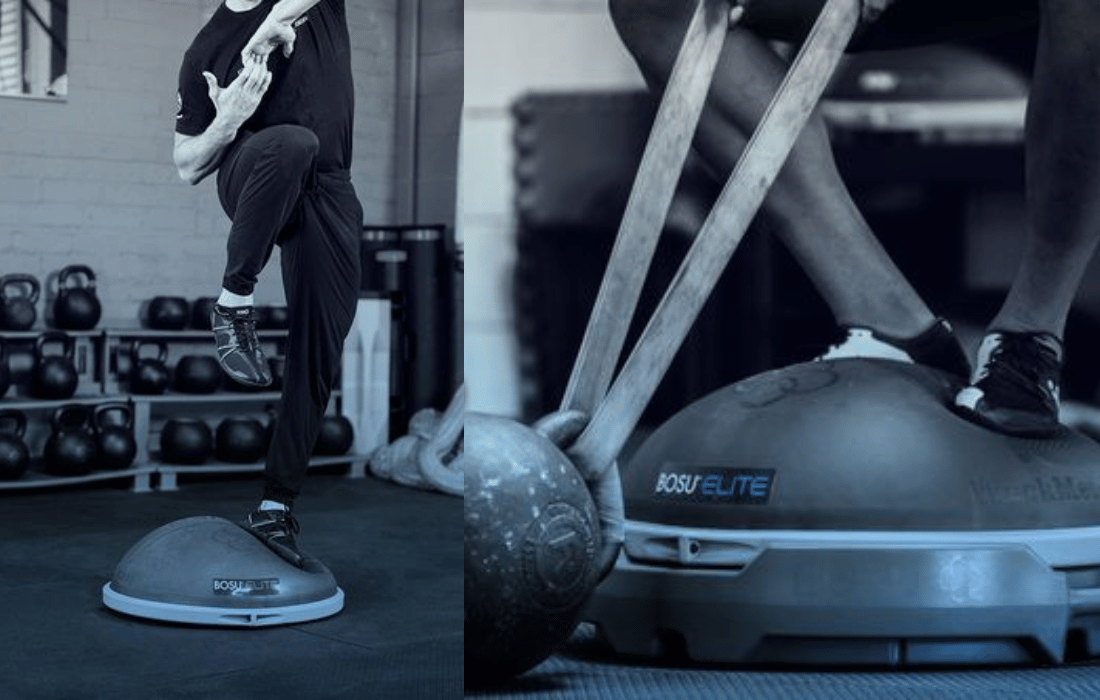Athletes across all disciplines share a common foundation—literally. Whether you’re grappling on the mats, sprinting down the track, or maneuvering a motocross bike through sharp corners, your feet are your first point of contact with the ground. They bear your weight, adapt to changing surfaces, and help stabilize your entire body. And yet, many athletes overlook foot health and balance training as critical components of their regimen.
In this article, we’ll dive deep into why athlete foot health is essential, the connection between foot strength and balance, and how Bosu ball training can take your athletic performance to the next level.
Why Foot Health Matters for Athletes
Your feet are more than just tools for walking or running—they are the unsung heroes of movement and performance. From providing balance and stability to absorbing impact, healthy feet allow athletes to move efficiently and prevent injuries.
A strong, flexible foot creates a solid foundation for the rest of your body, helping you react faster, cut sharper, and stay grounded when performing. Foot strength also plays a key role in injury prevention. Weak or imbalanced feet can lead to issues such as plantar fasciitis, Achilles tendonitis, or even knee, hip, and back pain.
For example, MMA fighters who rely heavily on fast footwork need solid, adaptable feet to pivot, strike, and maintain balance during takedowns. Similarly, motocross athletes need steady footing to absorb shocks and maintain control over their bikes during high-speed turns.
Despite their importance, many athletes spend far too little time training their feet or addressing balance deficits, which can lead to problems down the road.
The Athlete-Foot Connection
Your feet are your body’s foundation, but they’re also part of a broader system that involves ankles, calves, knees, and hips. This chain of movement allows athletes to move fluidly across different planes. When one link in this chain is weak, the others compensate—often leading to injury.
Athlete foot issues can manifest in various ways:
- Foot injuries: Plantar fasciitis, Achilles tendonitis, or stress fractures often arise from weak foot muscles and overuse.
- Impaired mobility: Tight foot muscles or limited ankle mobility can disrupt natural movement, leading to inefficient performance and compensatory movement patterns.
- Balance issues: Since your feet provide the foundation for balance, any imbalance or instability in the foot can throw off your entire body’s stability, impacting athletic performance.
That’s where balance training—particularly with a Bosu ball—comes into play.
What is a Bosu Ball?
 The Bosu ball is a half-sphere, inflatable balance trainer with a flat platform on one side and a rubber dome on the other. Its name stands for “Both Sides Utilized,” referring to the fact that you can use either side depending on the exercise.
The Bosu ball is a half-sphere, inflatable balance trainer with a flat platform on one side and a rubber dome on the other. Its name stands for “Both Sides Utilized,” referring to the fact that you can use either side depending on the exercise.
Bosu balls are widely used for balance training, functional workouts, and stability enhancement. They create an unstable surface, forcing athletes to engage more muscles and fine-tune their balance to perform exercises effectively.
It’s easy to see why Bosu ball training has become a staple for athletes in sports like MMA, motocross, surfing, and more. It helps athletes develop proprioception or body awareness and challenges their ability to stabilize on unstable surfaces—exactly what happens in real-life athletic situations.
Why Balance Training is Critical for Athletes
Balance is a key factor in performance. It enhances agility, quick decision-making, and body control. For combat sports athletes like wrestlers or MMA fighters, balance is crucial when engaging in clinches, takedowns, or defending against attacks. A motocross rider needs balance to stay upright and in control, especially on uneven terrains.
Training on unstable surfaces such as the Bosu ball improves balance by challenging your body’s stabilizer muscles. This training requires more neurological feedback to adjust your posture and stay upright, helping you build a strong neuromuscular connection and better control of your movements.
Balance training also has several benefits:
- Enhanced coordination: Training on a Bosu ball improves the coordination between your muscles and brain, helping you execute precise movements more effectively.
- Injury prevention: Weak balance can lead to awkward landings, twisted ankles, or falls. Bosu ball training strengthens your joints and stabilizer muscles, reducing the risk of these injuries.
- Improved core strength: Balance and core strength go hand-in-hand. Your core is constantly engaged during balance exercises, making this a great way to build a solid midsection while training balance.
Why Athletes Should Focus on Foot Health and Balance
Foot health and balance are critical for optimal athletic performance because they enable greater strength, agility, and resilience. Athletes often train for speed, power, and endurance but may neglect the smaller stabilizer muscles in their feet and lower legs, leading to imbalances. Over time, these imbalances can contribute to injuries, especially during high-intensity movements that require quick shifts in weight.
Incorporating balance-focused training into your routine improves functional strength. Functional exercises, like those on the Bosu ball, challenge the muscles you rely on during sport-specific actions—rather than just isolated muscle movements you may do at the gym.
A regular balance training routine also helps athletes learn how to shift their weight more effectively and control their body’s momentum, leading to greater efficiency and fewer chances of falling or misstepping.
The Role of Bosu Ball Training for Foot Health and Balance
Now, let’s take a closer look at how Bosu ball exercises can strengthen your feet and improve balance.
Bosu Ball Squats
This exercise strengthens your feet and ankles while engaging your core and lower body muscles. Squats on the Bosu ball also enhance your ability to balance while challenging your body’s stabilizer muscles.
- How to do it: Place the flat side of the Bosu ball on the ground and stand on top of the dome. Keep your feet shoulder-width apart. Slowly lower into a squat, making sure your knees stay behind your toes, then rise back to standing. Keep your core engaged to maintain balance.
- Benefits: This exercise improves lower body strength, foot and ankle stability, and balance.
Bosu Ball Single-Leg Balance
Single-leg exercises are a fantastic way to work on foot strength, stability, and balance, especially for athletes who perform unilateral movements like kicking, jumping, or cutting.
- How to do it: Stand on one leg in the center of the Bosu ball dome. Hold the position for 30 seconds, then switch legs. As you improve, you can try closing your eyes or performing small movements like reaching out with your arms or lifting the free leg forward and back.
- Benefits: This movement strengthens the muscles in your feet, ankles, and calves while improving proprioception and balance.
Bosu Ball Lateral Lunges
 Lunges are another great way to strengthen your feet, legs, and hips while improving lateral movement—a key skill for athletes in sports that involve side-to-side movements, such as tennis or basketball.
Lunges are another great way to strengthen your feet, legs, and hips while improving lateral movement—a key skill for athletes in sports that involve side-to-side movements, such as tennis or basketball.
- How to do it: Start with one foot on the Bosu ball and the other foot on the ground. Lunge laterally, bending the leg on the Bosu ball while keeping the opposite leg straight. Push back up to the starting position and repeat on the other side.
- Benefits: Lateral lunges on the Bosu ball improve your ability to shift your weight, enhance foot stability, and engage your core for balance.
Bosu Ball Toe Raises
Strengthening your toes and the arches of your feet is critical for foot health and balance. Toe raises on a Bosu ball make this exercise more challenging by adding instability.
- How to do it: Stand with the balls of your feet on the edge of the Bosu ball dome. Slowly lift your heels off the ground, rising onto your toes. Hold for a second, then lower back down. Perform 10-15 repetitions.
- Benefits: This exercise strengthens the muscles in your feet and toes, promoting better balance and foot strength.
How Bosu Ball Training Translates to Sports Performance
Training with a Bosu ball mimics the unpredictability of real-life athletic movements. Athletes often find themselves in unstable, shifting positions during competition—whether it’s grappling with an opponent, navigating a rough patch of terrain, or dodging defenders on the field. Bosu ball training prepares the body for these situations by challenging the athlete’s ability to stabilize and react quickly.
Take MMA fighters as an example: grappling, throwing kicks, and changing stances all require balance and agility. Training with a Bosu ball can help fighters improve their footwork, core stability, and overall movement efficiency, allowing them to maintain a strong base even when their opponent is trying to throw them off balance.
Similarly, motocross riders benefit from balance training because they often face unstable surfaces and sudden changes in terrain. Bosu ball training strengthens their ability to shift weight smoothly and stay grounded, preventing crashes or injuries on the track.
Final Thoughts: Incorporating Bosu Ball Training into Your Routine
Balance training and foot health are too important to ignore, no matter what sport you play. Adding Bosu ball exercises to your training regimen can help you improve your strength, coordination, and stability while reducing your risk of injury.
Remember, Bosu ball training is about challenging your body in new ways, so start slow and focus on mastering each exercise with proper form. Over time, you’ll notice improvements not only in your foot strength but also in your overall athletic performance.
The next time you step onto the mat, field, or track, your feet will thank you.







